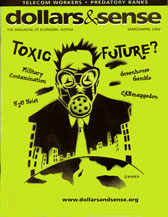
Dear Dr. Dollar:
What are the merits of the argument that rent control hurts tenants by limiting the incentives to create and maintain rental housing?
—Sarah Marxer, San Francisco, Calif.
This article is from the March/April 2003 issue of Dollars and Sense: The Magazine of Economic Justice available at http://www.dollarsandsense.org

This article is from the March/April 2003 issue of Dollars & Sense magazine.
Subscribe Now
at a discount.
The standard story of rent control, laid out in dozens of introductory economics textbooks, goes like this. In the housing market, landlords are willing to supply more rental units when prices are high, and tenants are willing to rent more units when prices are low. In an unregulated market, competition should result in a market-clearing price at which the number of apartments landlords are willing and able to provide just equals the number tenants are willing and able to rent. Thus, when prices are allowed to rise to their correct level, shortages disappear. Rent controls, in this story, disrupt the market mechanism by capping rents at too low a level. Artificially low rents discourage construction and maintenance, resulting in fewer available apartments than would exist without the controls. At the same time, low rents keep tenants in the area, searching for apartments that don’t exist. The result: permanent housing shortages in rent-controlled markets.
What’s wrong with this story? Just about everything.
First, the story ignores the unequal power that landlords and tenants exercise in an unregulated market. Boston College professor Richard Arnott notes that tenants are, for a number of reasons, averse to moving. This gives landlords inordinate pricing power even in a market where housing is not in short supply—and in areas where vacancy rates are low, land is scarce, and “snob zoning” commonplace, landlords can charge truly exorbitant prices. In Boston, rent controls were eliminated in 1997, and average apartment rents have since climbed nearly 100%. The city’s spiraling rents show that without controls, landlords can—and do—gouge tenants.
Second, rent control opponents misrepresent the structure of controls. As practiced in the real world, rent control does not place fixed caps on rent. New York City enacted an actual rent freeze after World War II, and a small number of apartments still fall under this “old-law” rent control. But most rent-controlled apartments in New York and all controlled apartments in other U.S. cities fall under what Arnott calls “second generation” or “soft” controls, which simply restrict annual rent increases. Soft rent controls guarantee landlords a “fair return” on their properties and require that owners maintain their buildings. They allow landlords to pass along maintenance costs, and many allow improvement costs to be recouped on an accelerated schedule, making building upkeep quite lucrative.
Consequently, controlled apartments are not unprofitable. And as Occidental College professor and housing specialist Peter Dreier points out, landlords won’t walk away as long as they are making a decent return. Residential landlords are not very mobile: they have a long-term interest in their properties, and only abandon them when market rents fall below even controlled levels as a result of poverty, crime, or economic depression. Rent controls themselves do not foster abandonment or poor maintenance.
Third, all second-generation rent control laws—enacted chiefly in the 1970s—exempted newly constructed buildings from controls. Thus, the argument that controls discourage new construction simply makes no sense. As for the oft-heard complaint that developers fear that rent controls, once enacted, will be extended to new buildings, the 1980s and 1990s construction booms in New York, Boston, San Francisco, and Los Angeles—all cities with controls—indicate that developers aren’t all that worried. There is plenty of housing and construction in cities with and without rent controls.
Nevertheless, even in many cities with rent controls, there is a shortage of affordable apartments. Market housing costs have been rising faster than wages for at least two decades. That some apartments in New York and San Francisco are still affordable to low- and middle-income families is due primarily to rent control.
Indeed, limited as they might be, rent controls deliver real benefits. They prevent price-gouging and ration scarce apartments to existing tenants. The money tenants save in rent can be spent in the neighborhood economy, benefiting local businesses. Meanwhile, more secure tenants create neighborhoods that are stable, safe, and economically diverse. And rent controls are essential if tenants are to have credible legal protection against slumlords: the legal right to complain about lack of heat or faulty plumbing is meaningless if landlords can retaliate by raising rents.
There are many problems with the U.S. housing market. High prices, low incomes, and lack of public housing or subsidies for affordable housing all contribute to homelessness and housing insecurity in major American cities. Rent control is not the cause of these problems, nor is it the whole solution. But along with higher wages and expanded public housing, it is part of the solution. As Dreier puts it, “Until the federal government renews its responsibility to help poor and working-class people fill the gap between what they can afford and what housing costs to build and operate, rent control can at least help to keep a roof over their heads.”
Did you find this article useful? Please consider supporting our work by donating or subscribing.
